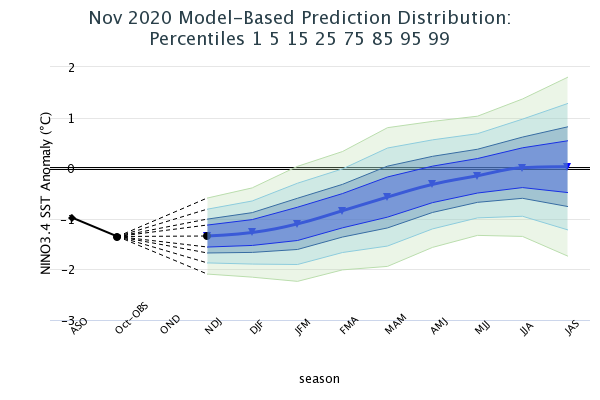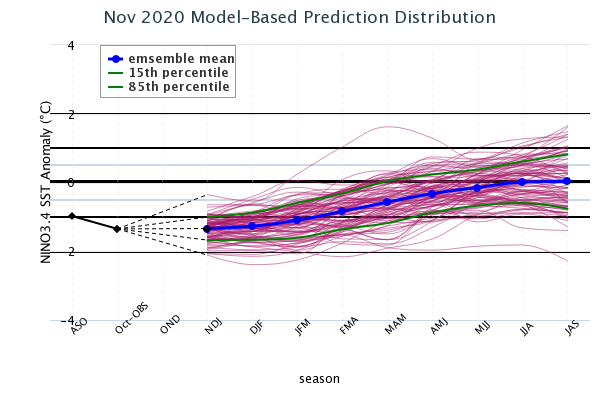IRI ENSO Forecast
IRI Technical ENSO Update and Model-Based Probabilistic ENSO Forecast
Published: November 19, 2020
Note: The SST anomalies cited below refer to the OISSTv2 SST data set, and not ERSSTv5. OISSTv2 is often used for real-time analysis and model initialization, while ERSSTv5 is used for retrospective official ENSO diagnosis because it is more homogeneous over time, allowing for more accurate comparisons among ENSO events that are years apart. During ENSO events, OISSTv2 often shows stronger anomalies than ERSSTv5, and during very strong events the two datasets may differ by as much as 0.5 C. Additionally, the ERSSTv5 may tend to be cooler than OISSTv2, because ERSSTv5 is expressed relative to a base period that is updated every 5 years, while the base period of OISSTv2 is updated every 10 years and so, half of the time, is based on a slightly older period and does not account as much for the slow warming trend in the tropical Pacific SST.
Recent and Current Conditions
In mid-November 2020, SSTs are well below average in the NINO3.4 region since late September. The October SST anomaly for NINO3.4 was -1.35 C, and for Aug-Oct it was -0.98 C, which is near the border between weak and moderate La Niña strength categories. The IRI’s definition of El Niño, like NOAA/Climate Prediction Center’s, requires that the SST anomaly in the NINO3.4 region (5S-5N; 170W-120W) exceed 0.5 C. Similarly, for La Niña, the anomaly must be -0.5 C or less. The climatological probabilities for La Niña, neutral, and El Niño conditions vary seasonally, and are shown in a table at the bottom of this page for each 3-month season. The most recent weekly anomaly in the NINO3.4 region was -1.0 C. All key atmospheric variables, such as the low-level and upper-level zonal wind anomalies and patterns of cloudiness and rainfall, indicate La Niña conditions. The traditional and equatorial Southern Oscillation Indices have been positive, and anomalously dry conditions have been observed around the date line through to the west-central part of the basin. Subsurface temperature anomalies in the central and eastern equatorial Pacific remain below average in mid-November. In summary, current conditions indicate La Niña. A La Niña advisory is in effect.
Expected Conditions
What is the outlook for the ENSO status going forward? The most recent official diagnosis and outlook was issued approximately one week ago in the NOAA/Climate Prediction Center ENSO Diagnostic Discussion, produced jointly by CPC and IRI; it states that La Niña conditions are present and are most likely to continue through boreal winter, with a 95% chance. The latest set of model ENSO predictions from mid-November, now available in the IRI/CPC ENSO prediction plume, is next discussed: As of mid-November, 100% of the collection of dynamical and statistical models predicts La Niña conditions for the initial Nov-Jan season, while only none predicts neutral conditions or El Niño. Percentages of models predicting La Niña remain over 90% through the Jan-Mar season, and then drop going forward into spring: approximately 80% for Feb-Apr, 65% for Mar-May, and 33% for Apr-Jun. The percentage of models predicting neutral increases to 20% for Feb-Apr, and begins exceeding 50% starting in Apr-Jun. Percentages of models predicting El Niño are 0% through Feb-Apr, and then rise to 10-15% from May-Jul through Jun-Aug.
Note – Only models that produce a new ENSO prediction every month are included in the above statement.
Caution is advised in interpreting the distribution of model predictions shown in the prediction plume as the actual probabilities. At longer leads, the skill of the models degrades, and uncertainty in skill must be convolved with the uncertainties from initial conditions and differing model physics, which leads to more climatological probabilities in the long-lead ENSO Outlook than might be suggested by the suite of models. Furthermore, the expected skill of one model versus another has not been established using uniform validation procedures, which may cause a difference in the true probability distribution from that taken verbatim from the raw model predictions.
An alternative way to assess the probabilities of the three possible ENSO conditions is more quantitatively precise and less vulnerable to sampling errors than the categorical tallying method used above. This alternative method uses the mean value of the NINO3.4 SST anomaly predictions of all models on the plume, equally weighted, and constructs a standard error function centered on that mean. The standard error is Gaussian in shape, and has its width determined by an estimate of overall expected model skill for the season of the year and the lead time. Higher skill results in a relatively narrower error distribution, while low skill results in an error distribution with width approaching that of the historical observed distribution. Using this method, chances for La Niña are 99% for the Nov-Jan season, while chances for ENSO-neutral are 1%. Going forward, probabilities for La Niña decrease to 92% by Jan-Mar, 80% for Feb-Apr, and then dropping to around 20-30% from Apr-Jun through Jul-Sep. Chances for neutral increase to a peak likelihood of 65% for Apr-Jun. El Niño probabilities are less than 10% through Apr-Jun, then rise to 26% by Jul-Sep. A plot of the probabilities generated from this most recent IRI/CPC ENSO prediction plume using the multi-model mean and the Gaussian standard error method summarizes the model consensus out to about 10 months into the future.
The same cautions mentioned above for the distributional count of model predictions apply to this Gaussian standard error method of inferring probabilities, due to differing model biases and skills. In particular, this approach considers only the mean of the predictions, and not the total range across the models, nor the ensemble range within individual models.
In summary, the probabilities derived from the models on the IRI/CPC plume describe a very slim chance for El Niño conditions throughout most of the forecast period, and a strong preference for La Niña conditions relative to neutral conditions from the initial season of Nov-Jan extending through Feb-Apr. By the Apr-Jun season, neutral becomes the more likely outcome through the remaining forecast periods, through Jul-Sep.
A caution regarding this latest set of model-based ENSO plume predictions, is that factors such as known specific model biases and recent changes in the tropical Pacific that the models may have missed will be taken into account in the next official outlook to be generated and issued early next month by CPC and IRI, which will include some human judgment in combination with the model guidance.

IRI/CPC Mid-Month Model-Based ENSO Forecast Probabilities
| Season |
La Niña |
Neutral |
El Niño |
| NDJ 2020 |
99% |
1% |
0% |
| DJF 2021 |
97% |
3% |
0% |
| JFM 2021 |
92% |
8% |
0% |
| FMA 2021 |
80% |
20% |
0% |
| MAM 2021 |
57% |
42% |
1% |
| AMJ 2021 |
33% |
64% |
3% |
| MJJ 2021 |
26% |
63% |
11% |
| JJA 2021 |
22% |
56% |
22% |
| JAS 2021 |
23% |
51% |
26% |





